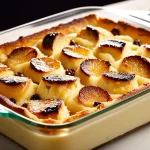Essential Ingredients and Preparation for Sticky Toffee Pudding
When preparing sticky toffee pudding, mastering the sticky toffee pudding ingredients is crucial to creating that signature rich and moist texture. The core components include finely chopped dates, strong black tea or boiling water for soaking, self-raising flour, brown sugar, butter, eggs, and golden syrup. Each ingredient plays a vital role in balancing sweetness and ensuring the pudding achieves its delightful density.
The most important step is date preparation. Soaking chopped dates in boiling water or brewed tea softens the fruit, releasing deep, caramel-like flavours that permeate the sponge. Allow at least 10-15 minutes for the dates to soak, as this hydration prevents a dry texture. Using black tea instead of water can intensify the flavour subtly, making the pudding more aromatic.
Also to discover : What Innovative British Recipes Can Simplify Weeknight Dinners?
Accuracy in preparing sticky toffee pudding means carefully measuring butter and sugar to avoid an overly greasy or overly sweet cake. Sift the flour to maintain fluffiness, and beat eggs properly to distribute air. Handling the ingredients with precision ensures a perfectly balanced pudding that’s tender, moist, and packed with flavour.
Step-by-Step Guide to Making the Sponge
Mastering the sticky toffee pudding sponge begins with the correct technique for mixing the sponge batter. Start by carefully combining your wet and dry ingredients separately. This approach ensures the flour integrates smoothly without developing gluten, which keeps the sponge light and fluffy.
This might interest you : What are the steps to crafting a rich and creamy bread and butter pudding?
When it comes to incorporating dates, chop them finely and fold them in gently. Overmixing can activate too much gluten, leading to a dense texture—exactly what you want to avoid. Remember, the batter should be just combined, and a few lumps are perfectly fine.
Baking this sponge requires precision. Preheat your oven and bake the sponge for about 30 to 35 minutes, depending on your oven’s quirks. Check for doneness by inserting a toothpick into the center; if it comes out clean or with a few moist crumbs, your sponge is ready. Baking too long will dry it out, undermining that classic sticky toffee softness.
Following these baking tips ensures a tender, velvety sponge that forms the perfect base for your indulgent sticky toffee pudding dessert.
Crafting the Toffee Sauce
Discover the secrets to a luscious sticky toffee pudding sauce
Creating an exceptional toffee sauce recipe hinges on balancing key ingredients: brown sugar for its deep molasses flavor, unsalted butter to add richness, and double cream to ensure silkiness. Precise ratios matter; typically, equal parts butter, sugar, and cream create the perfect harmony.
When making toffee sauce, melt butter gently over medium heat to avoid scorching. Gradually add sugar, stirring continuously until it dissolves fully, which prevents grittiness. Incorporate cream slowly while stirring to preserve a smooth texture. Using moderate heat and patience guarantees a glossy, velvety finish.
To prevent crystallisation and burnt sauce, avoid rapid temperature changes, as sudden cooling or overheating causes sugar to seize. Stir consistently but gently, and refrain from high heat which risks burning. A dash of golden syrup or corn syrup can also inhibit crystal formation, ensuring the sauce remains fluid and shiny. Mastering these steps yields a sublime sticky toffee pudding sauce that complements desserts perfectly.
Assembling, Serving, and Storage Advice
Enhance your sticky toffee pudding experience with expert tips.
Pouring toffee sauce over the warm sponge immediately after baking ensures the sauce absorbs deeply, creating that rich, moist texture sticky toffee pudding is famous for. This technique locks in moisture and flavor, making every bite indulgent. For serving sticky toffee pudding, traditional accompaniments like vanilla ice cream or clotted cream complement the intense sweetness and balance the richness beautifully. Some prefer a simple sprinkle of chopped nuts for added texture.
When storing leftovers, wrap the pudding airtight or place it in a sealed container to maintain moisture and prevent drying out. Refrigerate for up to three days. To reheat, cover loosely with foil and warm in the oven at 150°C (300°F) until heated through, ensuring the sponge stays tender. Adding a fresh drizzle of toffee sauce after reheating restores its signature lusciousness.
Following these assembling, serving, and storage guidelines guarantees your sticky toffee pudding remains a delightful treat, ready to enjoy again or share with guests without sacrificing its classic charm.
Troubleshooting Common Mistakes and Expert Tips
When tackling sticky toffee pudding troubleshooting, one common issue is a dense or dry sponge. This often happens when overmixing or baking for too long. To fix this, ensure you gently fold ingredients and keep an eye on baking times — cakey and moist should be your goal. Using fresh baking powder can also make a noticeable difference.
For the toffee sauce, separation or curdling is frustrating but preventable. When warming caramel, avoid high heat; instead, simmer gently and stir constantly. Adding cream gradually helps maintain a smooth texture and stops separation. If curdling occurs, gently whisk the sauce off heat to bring it back together.
To elevate your sticky toffee pudding presentation and flavour, try warming the dish before serving to enhance richness. A sprinkle of sea salt can balance sweetness and add complexity. Finally, topping with a scoop of quality vanilla ice cream or a dollop of whipped cream adds the perfect creamy contrast. These baking tips are essential in mastering this beloved dessert.


